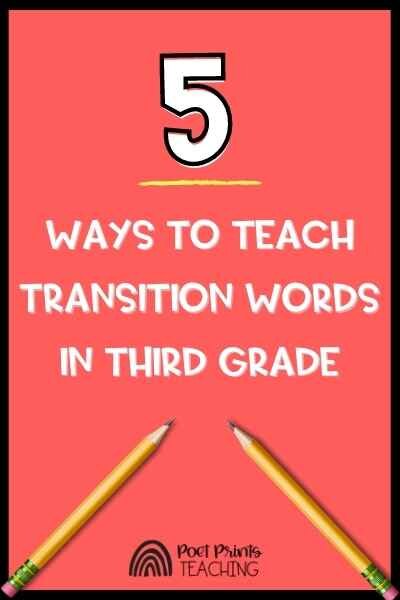5 Ways to Teach Transition Words in Third Grade
First, kids learn letters. Second, they learn words. Then, they use phrases. Afterward, they use sentences. At some point, they learn transition words. Do you see what I did there? Transition words are important to help with the flow of writing. We, as adults, often use these words without even thinking about it. But we need to explicitly teach transition words to our students. So I thought I’d put together a list of some fun ways to teach transition words in third grade.
Text: 5 Ways to Teach Transition Words in Third Grade
Image: Two pencils are displayed on a red background
How Do You Teach Transition Words in Third Grade?
I think we can all agree that transition words are important. But we’ve all seen writing where students just repeat the same transition words over and over. How many times have we read an essay that has “And then…..And then…..And then…..” It’s up to us to explicitly teach transition words to our students. Otherwise, we’re doomed to read “And then….” essays for the rest of the school year. There are a variety of strategies that we can employ to help students learn their transition words.
1. Write a Class Story Together
One way that I love to teach transition words is through modeled class stories. I will set up my flip chart with some transitional phrases. It might look something like this:
Once upon a time, there was a __________ and a _________.
First they _________________
Next they ________________.
Afterwards, they ________________.
Finally, they ___________________.
It was a _________ day.
Students love filling in the blanks together. In the end you might end up with a story like this:
Once upon a time, there was a frog and a duck. First they had a swimming competition. Next they went for lunch at McDonalds. Afterwards, they had a jumping competition. Finally, they went to bed because they were tired. It was a long and busy day.
Students like to create class stories together and share their ideas. After doing a story as a whole class, you could put students into groups and have them create their own stories, using the same template. Or you could have students create stories individually. Personally, I like doing it as a large group and then as small groups, because this fosters cooperation and communication skills.
2. Use Your Fingers
When students start thinking about the order of events in their story, I get students to use their fingers as they say each event. This helps them identify the order or first, second, third….and so on. Now, it’s OK if they use the “first, second, third…” as transition words, but you’ll also want to teach them other words to expand their vocabulary and make their writing flow better.
3. Create a Simple How-To Book
This is a super effective transition word resource that teaches students to use 3-4 transition words to write a simple instructional ‘how to’ story. As a class, we create a book titled “How to Do Almost Anything in Four Easy Steps!”. This helps to get students in the mindset of writing their ideas in the correct order and teaches the importance of basic transition words. I find that this is a great lesson for the beginning of the year.
In this package, you’ll find sequence word cards to display in your classroom, planning paper, a self-assessment tool, the class book title page, and a variety of story papers for students to write on.
4. Video the Outcome
To take this above resource one step further, you can have students create a step by step guide of how to make a peanut butter and jam sandwich, and then video the outcome. One of my teacher-friends does this with her class each year. First, she shows this video of a Dad recreating his children’s instructions for making a sandwich. It’s quite funny!
After watching this video, the students have to write down instructions for how to make a peanut butter and jam sandwich. What the students don’t know is that my friend takes their instructions and creates a video of herself following the instructions. At one point, she even put peanut butter on her face because the student wrote “Put peanut butter on face.”
Yes, this is a messy and silly idea. However, after this lesson, her students were extra careful when sequencing their writing.
5. Traffic Light Transitions
I stumbled across the video below all about Traffic Light Transitions. It would be so easy to turn this into an anchor chart for the classroom. Students can help you brainstorm different transition words or phrases that belong in each section.
Teaching transition words doesn’t have to be complicated. Even simple methods like these will help students to grasp the concept. And remember, the more students practice, the more adept they become at using transition words in their writing.
BONUS IDEA: Practice transition words in journals
I am a huge fan of journal writing in third grade, it’s one of my favorite ways to build relationships and formatively assess writing. Once we have learned transition words, and students have access to a bank of transition words, personal journals are a great place to practice using them on a regular basis. Retelling events from our week naturally lends itself to using transition words, so it’s awesome practice. You can snag some of my favorite journal prompts below!
Pin me for later!
Text: 5 Ways to teach transition words in third grade
Image: School supplies are displayed on a piece of paper.


